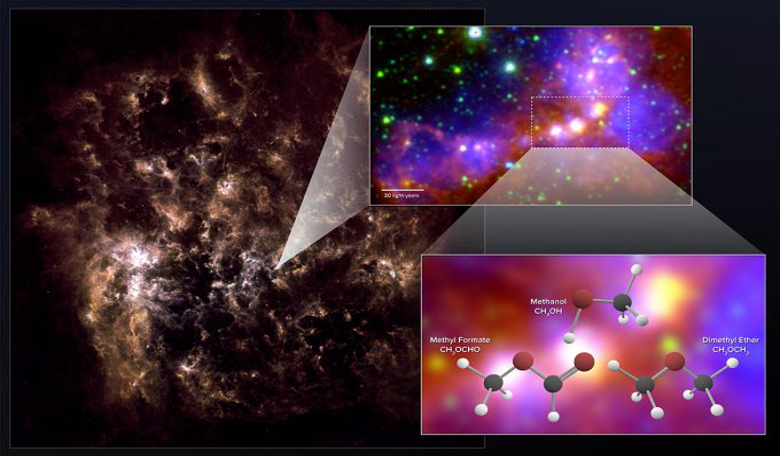The nearby dwarf galaxy known as the Large Magellanic Cloud (LMC) once thought to be a chemically primitive place, has surprised astronomers with an unexpected discovery – the chemical signatures of dimethyl ether and methyl formate – two complex molecules that have never conclusively been detected outside of our galaxy.
Unlike the Milky Way, the LMC is referred to as a “low metallicity” galaxy because it lacks the rich abundance of heavy elements, like carbon, nitrogen and oxygen found in our galaxy. To become rich in heavy elements it can take several generations of the star birth and star death cycle to populate a galaxy with heavy elements, and once liberally strewn about, the elements can then become the material with which planets are built.
“Young, primordial galaxies simply didn’t have enough time to become so chemically enriched,” said Marta Sewiło, an astronomer with NASA’s Goddard Space Flight Center in Greenbelt, Maryland, and lead author on a paper appearing in the Astrophysical Journal Letters. “Dwarf galaxies like the LMC probably retained this same youthful makeup because of their relatively low masses, which severely throttles back the pace of star formation.”
However, new observations with the Atacama Large Millimeter/submillimeter Array (ALMA) by Sewilo and team, have revealed the chemical signatures of the complex organic molecules dimethyl ether and methyl formate. The team also found a clear indication that methanol is also present – a species that had previously been hinted at, but not completely confirmed.
Some of the basic building blocks of molecules that are essential to life on Earth (and as far as we know it elsewhere in the Universe), are complex organic molecules that are made-up of six or more atoms including carbon. Although it is considered a relatively simple compound compared to its larger counterparts, even methanol (CH3OH) has a role to play in the creation of more complex organic molecules.
The molecules were found around a group of young protostars – very young stars that are still gathering mass from their parent molecular cloud. If these complex molecules can readily form around the harsh and irradiating regions surrounding protostars, it is quite possible that they would continue to survive as the protoplanetary disks around the young star systems evolved to create planets.
If that is the case, then it is also likely that such molecules could have been delivered to the primitive Earth by comets and meteorites, helping to jumpstart the development of life on our planet - and perhaps elsewhere.
“Even though the Large Magellanic Cloud is one of our nearest galactic companions, we expect it should share some uncanny chemical similarity with distant, young galaxies from the early Universe,” said Sewilo.
Sewilo and team thus speculate that since complex organic molecules can form in chemically primitive environments like the LMC, then it is reasonable to suggest that the chemical framework needed for life could have started relatively early in the history of the Universe.











